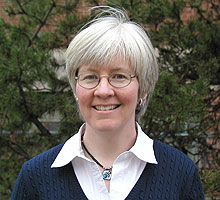  |
| HOME | THIS ISSUE | CALENDAR | GRANTS | BACK ISSUES | < BACK | NEXT > |
Environmental engineer studies how antibiotics affect water, soilby Nan Cooper - October 1, 2007 | ||||
| To keep them healthy, farm animals such as cattle, pigs, and even farmed fish are usually fed agricultural antibiotics. These are then excreted in the animal’s feces and, after time, are washed into streams and rivers. The addition of antibiotics to waterways can be a problem, as the U. S. Geological Survey found three years ago when it studied fish in tributaries of the Potomac River. Scientists discovered a “high incidence” of male smallmouth bass carrying eggs in their testes. Analysis of the water showed measurable levels of antibiotics, animal feed additives, arsenic, pesticides, and other so-called “endocrine disruptors” – pharmaceutical or natural compounds that alter the ordinary functioning of hormones in living things. Research conducted by Allison MacKay, an associate professor of civil and environmental engineering, aims to help scientists better understand how antibiotics and other organic compounds enter the nation’s waterways, disperse, and change over time. “Antibiotics are designed to be biologically active even at low levels,” MacKay says, “so their impacts and environmental interactions can be much subtler and complex than many contaminants.” MacKay, along with Dharni Vasudevan, associate professor of chemistry at Bowdoin College, is undertaking research supported by the U.S. Department of Agriculture and the National Science Foundation. It seeks to unveil the fate of biological contaminants in soil and water: how – and how far – they travel, how they change over time, how they are degraded, and so forth. According to MacKay, sunlight, temperature, flow rate, bacteria and other microorganisms, soil types, and mineral composition all may affect how these antibiotics are degraded. She says antibiotics tend to remain active longer in soil than in water, for a variety of reasons.
“In water,” she notes, “if these compounds remain close to the surface, they may be broken down by sunlight. Antibiotics may also be degraded by bacteria more quickly in water than in soil.” It is in the soil that MacKay and Vasudevan are focusing their research to determine how different soil compositions may affect the movement and active life of antibiotics such as tetracycline. So far, most of their research has been conducted in the lab, where different soil types have been tested and characterized chemically. The team’s studies have focused on soils containing high levels of iron oxide or clay. MacKay has found that soil containing greater amounts of clay – in contrast with porous, sandy types – tends to bind the antibiotics, thus hampering their movement through the soil and into groundwater, rivers, and streams. Once the team finishes characterizing the soils and completes further tests, it will develop a mathematical model that replicates the movement and fate of the antibiotics as they move through soils of different composition. They ultimately hope to expand the scope of the model to accurately reflect the movement of not only tetracycline but a wider array of antibiotics. |
| ADVANCE HOME UCONN HOME |

